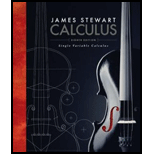
Single Variable Calculus
8th Edition
ISBN: 9781305266636
Author: James Stewart
Publisher: Cengage Learning
expand_more
expand_more
format_list_bulleted
Concept explainers
Textbook Question
Chapter 5, Problem 30RE
A steel tank has the shape of a circular cylinder oriented vertically with diameter 4 m and height 5 m. The tank is currently filled to a level of 3 m with cooking oil that has a density of 920 kg/m3. Compute the work required to pump the oil out through a 1-meter spout at the top of the tank.
Expert Solution & Answer
Trending nowThis is a popular solution!

Chapter 5 Solutions
Single Variable Calculus
Ch. 5.1 - Find the area of the shaded region.Ch. 5.1 - Find the area of the shaded region.Ch. 5.1 - Find the area of the shaded region.Ch. 5.1 - Find the area of the shaded region.Ch. 5.1 - Sketch the region enclosed by the given curves....Ch. 5.1 - Prob. 6ECh. 5.1 - Sketch the region enclosed by the given curves....Ch. 5.1 - Prob. 8ECh. 5.1 - Sketch the region enclosed by the given curves....Ch. 5.1 - Sketch the region enclosed by the given curves....
Ch. 5.1 - Prob. 11ECh. 5.1 - Sketch the region enclosed by the given curves....Ch. 5.1 - Prob. 13ECh. 5.1 - Sketch the region enclosed by the given curves and...Ch. 5.1 - Sketch the region enclosed by the given curves and...Ch. 5.1 - Sketch the region enclosed by the given curves and...Ch. 5.1 - Prob. 17ECh. 5.1 - Prob. 18ECh. 5.1 - Prob. 19ECh. 5.1 - Prob. 20ECh. 5.1 - Sketch the region enclosed by the given curves and...Ch. 5.1 - Prob. 22ECh. 5.1 - Sketch the region enclosed by the given curves and...Ch. 5.1 - Sketch the region enclosed by the given curves and...Ch. 5.1 - Prob. 25ECh. 5.1 - Sketch the region enclosed by the given curves and...Ch. 5.1 - Prob. 27ECh. 5.1 - Prob. 28ECh. 5.1 - Prob. 29ECh. 5.1 - Prob. 30ECh. 5.1 - Prob. 31ECh. 5.1 - Prob. 32ECh. 5.1 - Prob. 33ECh. 5.1 - Prob. 34ECh. 5.1 - Prob. 35ECh. 5.1 - Evaluate the integral and interpret it as the area...Ch. 5.1 - Prob. 37ECh. 5.1 - Prob. 38ECh. 5.1 - Prob. 39ECh. 5.1 - Prob. 40ECh. 5.1 - Prob. 41ECh. 5.1 - Graph the region between the curves and use your...Ch. 5.1 - Prob. 43ECh. 5.1 - Prob. 44ECh. 5.1 - Use a computer algebra system to find the exact...Ch. 5.1 - Prob. 46ECh. 5.1 - Racing cars driven by Chris and Kelly are side by...Ch. 5.1 - The widths (in meters) of a kidney-shaped swimming...Ch. 5.1 - A cross-section of an airplane wing is shown....Ch. 5.1 - If the birth rate of a population is b(t) = 2200 +...Ch. 5.1 - In Example 5, we modeled a measles pathogenesis...Ch. 5.1 - The rates at which rain fell, in inches per hour,...Ch. 5.1 - Two cars, A and B, start side by side and...Ch. 5.1 - The figure shows graphs of the marginal revenue...Ch. 5.1 - Prob. 55ECh. 5.1 - Prob. 56ECh. 5.1 - Prob. 57ECh. 5.1 - (a) Find the number a such that the line x = a...Ch. 5.1 - Find the values of c such that the area of the...Ch. 5.1 - Prob. 60ECh. 5.1 - Prob. 61ECh. 5.1 - Prob. 62ECh. 5.1 - Prob. 63ECh. 5.1 - For what values of m do the line y = mx and the...Ch. 5.2 - Find the volume of the solid obtained by rotating...Ch. 5.2 - Find the volume of the solid obtained by rotating...Ch. 5.2 - Find the volume of the solid obtained by rotating...Ch. 5.2 - Find the volume of the solid obtained by rotating...Ch. 5.2 - Find the volume of the solid obtained by rotating...Ch. 5.2 - Find the volume of the solid obtained by rotating...Ch. 5.2 - Find the volume of the solid obtained by rotating...Ch. 5.2 - Prob. 8ECh. 5.2 - Prob. 9ECh. 5.2 - Prob. 10ECh. 5.2 - Prob. 11ECh. 5.2 - Prob. 12ECh. 5.2 - Find the volume of the solid obtained by rotating...Ch. 5.2 - Find the volume of the solid obtained by rotating...Ch. 5.2 - Prob. 15ECh. 5.2 - Find the volume of the solid obtained by rotating...Ch. 5.2 - Find the volume of the solid obtained by rotating...Ch. 5.2 - Prob. 18ECh. 5.2 - Refer to the figure and find the volume generated...Ch. 5.2 - Refer to the figure and find the volume generated...Ch. 5.2 - Refer to the figure and find the volume generated...Ch. 5.2 - Prob. 22ECh. 5.2 - Refer to the figure and find the volume generated...Ch. 5.2 - Prob. 24ECh. 5.2 - Refer to the figure and find the volume generated...Ch. 5.2 - Refer to the figure and find the volume generated...Ch. 5.2 - Refer to the figure and find the volume generated...Ch. 5.2 - Prob. 28ECh. 5.2 - Refer to the figure and find the volume generated...Ch. 5.2 - Prob. 30ECh. 5.2 - Set up an integral for the volume of the solid...Ch. 5.2 - Set up an integral for the volume of the solid...Ch. 5.2 - Set up an integral for the volume of the solid...Ch. 5.2 - Prob. 34ECh. 5.2 - Prob. 35ECh. 5.2 - Prob. 36ECh. 5.2 - Use a computer algebra system to find the exact...Ch. 5.2 - Use a computer algebra system to find the exact...Ch. 5.2 - Prob. 39ECh. 5.2 - Prob. 40ECh. 5.2 - Prob. 41ECh. 5.2 - Prob. 42ECh. 5.2 - A CAT scan produces equally spaced cross-sectional...Ch. 5.2 - Prob. 44ECh. 5.2 - Prob. 45ECh. 5.2 - Prob. 46ECh. 5.2 - Prob. 47ECh. 5.2 - Find the volume of the described solid S. 48.A...Ch. 5.2 - Find the volume of the described solid S. 49.A cap...Ch. 5.2 - Find the volume of the described solid S. 50. A...Ch. 5.2 - Prob. 51ECh. 5.2 - Find the volume of the described solid S. 52. A...Ch. 5.2 - Prob. 53ECh. 5.2 - Find the volume of the described solid S. 54. The...Ch. 5.2 - Find the volume of the described solid S. 55. The...Ch. 5.2 - Prob. 56ECh. 5.2 - Prob. 57ECh. 5.2 - Prob. 58ECh. 5.2 - Prob. 59ECh. 5.2 - Prob. 60ECh. 5.2 - Prob. 61ECh. 5.2 - The base of S is a circular disk with radius r....Ch. 5.2 - (a) Set up an integral for the volume of a solid...Ch. 5.2 - Prob. 64ECh. 5.2 - (a) Cavalieris Principle states that if a family...Ch. 5.2 - Find the volume common to two circular cylinders,...Ch. 5.2 - Prob. 67ECh. 5.2 - A bowl is shaped like a hemisphere with diameter...Ch. 5.2 - A hole of radius r is bored through the middle of...Ch. 5.2 - A hole of radius r is bored through the center of...Ch. 5.2 - Prob. 71ECh. 5.2 - Suppose that a region R has area A and lies above...Ch. 5.3 - Let S be the solid obtained by rotating the region...Ch. 5.3 - Let S be the solid obtained by rotating the region...Ch. 5.3 - Prob. 3ECh. 5.3 - Prob. 4ECh. 5.3 - Prob. 5ECh. 5.3 - Prob. 6ECh. 5.3 - Prob. 7ECh. 5.3 - Let V be the volume of the solid obtained by...Ch. 5.3 - Use the method of cylindrical shells to find the...Ch. 5.3 - Use the method of cylindrical shells to find the...Ch. 5.3 - Use the method of cylindrical shells to find the...Ch. 5.3 - Use the method of cylindrical shells to find the...Ch. 5.3 - Use the method of cylindrical shells to find the...Ch. 5.3 - Use the method of cylindrical shells to find the...Ch. 5.3 - Use the method of cylindrical shells to find the...Ch. 5.3 - Use the method of cylindrical shells to find the...Ch. 5.3 - Use the method of cylindrical shells to find the...Ch. 5.3 - Use the method of cylindrical shells to find the...Ch. 5.3 - Use the method of cylindrical shells to find the...Ch. 5.3 - Use the method of cylindrical shells to find the...Ch. 5.3 - (a) Set up an integral for the volume of the solid...Ch. 5.3 - Prob. 22ECh. 5.3 - Prob. 23ECh. 5.3 - Prob. 24ECh. 5.3 - Prob. 25ECh. 5.3 - Prob. 26ECh. 5.3 - Prob. 27ECh. 5.3 - If the region shown in the figure is rotated about...Ch. 5.3 - Prob. 29ECh. 5.3 - Prob. 30ECh. 5.3 - Prob. 31ECh. 5.3 - Prob. 32ECh. 5.3 - Prob. 33ECh. 5.3 - Prob. 34ECh. 5.3 - Prob. 35ECh. 5.3 - Use a computer algebra system to find the exact...Ch. 5.3 - Prob. 37ECh. 5.3 - Prob. 38ECh. 5.3 - Prob. 39ECh. 5.3 - Prob. 40ECh. 5.3 - Prob. 41ECh. 5.3 - Prob. 42ECh. 5.3 - Prob. 43ECh. 5.3 - Let T be the triangular region with vertices (0,...Ch. 5.3 - Prob. 45ECh. 5.3 - Use cylindrical shells to find the volume of the...Ch. 5.3 - Prob. 47ECh. 5.3 - Suppose you make napkin rings by drilling holes...Ch. 5.4 - A 360-lb gorilla climbs a tree to a height of 20...Ch. 5.4 - How much work is done when a hoist lifts a 200-kg...Ch. 5.4 - Prob. 3ECh. 5.4 - Prob. 4ECh. 5.4 - Shown is the graph of a force function (in...Ch. 5.4 - Prob. 6ECh. 5.4 - Prob. 7ECh. 5.4 - A spring has a natural length of 40 cm. If a 60-N...Ch. 5.4 - Suppose that 2 J of work is needed to stretch a...Ch. 5.4 - Prob. 10ECh. 5.4 - Prob. 11ECh. 5.4 - Prob. 12ECh. 5.4 - Prob. 13ECh. 5.4 - Prob. 14ECh. 5.4 - Prob. 15ECh. 5.4 - Prob. 16ECh. 5.4 - Show how to approximate the required work by a...Ch. 5.4 - Prob. 18ECh. 5.4 - Prob. 19ECh. 5.4 - Show how to approximate the required work by a...Ch. 5.4 - Prob. 21ECh. 5.4 - Show how to approximate the required work by a...Ch. 5.4 - A tank is full of water. Find the work required to...Ch. 5.4 - A tank is full of water. Find the work required to...Ch. 5.4 - A tank is full of water. Find the work required to...Ch. 5.4 - A tank is full of water. Find the work required to...Ch. 5.4 - Prob. 27ECh. 5.4 - Prob. 28ECh. 5.4 - When gas expands in a cylinder with radius r, the...Ch. 5.4 - In a steam engine the pressure P and volume V of...Ch. 5.4 - The kinetic energy KE of an object of mass m...Ch. 5.4 - Suppose that when launching an 800-kg roller...Ch. 5.4 - Prob. 33ECh. 5.4 - The Great Pyramid of King Khufu was built of...Ch. 5.5 - Find the average value of the function on the...Ch. 5.5 - Prob. 2ECh. 5.5 - Find the average value of the function on the...Ch. 5.5 - Prob. 4ECh. 5.5 - Prob. 5ECh. 5.5 - Prob. 6ECh. 5.5 - Prob. 7ECh. 5.5 - Prob. 8ECh. 5.5 - (a) Find the average value of f on the given...Ch. 5.5 - Prob. 10ECh. 5.5 - Prob. 11ECh. 5.5 - Prob. 12ECh. 5.5 - If f is continuous and 13f(x)dx=8, show that f...Ch. 5.5 - Prob. 14ECh. 5.5 - Find the average value of f on [0, 8].Ch. 5.5 - The velocity graph of an accelerating car is...Ch. 5.5 - Prob. 17ECh. 5.5 - The velocity v of blood that flows in a blood...Ch. 5.5 - The linear density in a rod 8 m long is...Ch. 5.5 - Prob. 20ECh. 5.5 - Prob. 21ECh. 5.5 - Use the diagram to show that if f is concave...Ch. 5.5 - Prob. 23ECh. 5.5 - Prob. 24ECh. 5 - (a) Draw two typical curves y = f(x) and y = g(x),...Ch. 5 - Prob. 2RCCCh. 5 - Prob. 3RCCCh. 5 - Prob. 4RCCCh. 5 - Prob. 5RCCCh. 5 - Prob. 6RCCCh. 5 - Prob. 1RECh. 5 - Find the area of the region bounded by the given...Ch. 5 - Find the area of the region bounded by the given...Ch. 5 - Prob. 4RECh. 5 - Prob. 5RECh. 5 - Prob. 6RECh. 5 - Prob. 7RECh. 5 - Prob. 8RECh. 5 - Prob. 9RECh. 5 - Prob. 10RECh. 5 - Find the volume of the solid obtained by rotating...Ch. 5 - Set up, but do not evaluate, an integral for the...Ch. 5 - Prob. 13RECh. 5 - Set up, but do not evaluate, an integral for the...Ch. 5 - Find the volumes of the solids obtained by...Ch. 5 - Let R be the region in the first quadrant bounded...Ch. 5 - Prob. 17RECh. 5 - Let R be the region bounded by the curves y = 1 ...Ch. 5 - Prob. 19RECh. 5 - Prob. 20RECh. 5 - Prob. 21RECh. 5 - Prob. 22RECh. 5 - Prob. 23RECh. 5 - Prob. 24RECh. 5 - The height of a monument is 20 m. A horizontal...Ch. 5 - Prob. 26RECh. 5 - Prob. 27RECh. 5 - Prob. 28RECh. 5 - A tank full of water has the shape of a paraboloid...Ch. 5 - A steel tank has the shape of a circular cylinder...Ch. 5 - Prob. 31RECh. 5 - (a) Find the average value of the function...Ch. 5 - If f is a continuous function, what is the limit...Ch. 5 - Let R1 be the region bounded by y = x2, y = 0, and...Ch. 5 - Prob. 1PCh. 5 - There is a line through the origin that divides...Ch. 5 - The figure shows a horizontal line y = c...Ch. 5 - A cylindrical glass of radius r and height L is...Ch. 5 - (a) Show that the volume of a segment of height h...Ch. 5 - Prob. 6PCh. 5 - Prob. 7PCh. 5 - Prob. 8PCh. 5 - The figure shows a curve C with the property that,...Ch. 5 - A paper drinking cup filled with water has the...Ch. 5 - A clepsydra, or water clock, is a glass container...Ch. 5 - A cylindrical container of radius r and height L...Ch. 5 - Prob. 13PCh. 5 - If the tangent at a point P on the curve y = x3...
Knowledge Booster
Learn more about
Need a deep-dive on the concept behind this application? Look no further. Learn more about this topic, calculus and related others by exploring similar questions and additional content below.Similar questions
- Suppose that r=12 cm and h=15 cm in the right circular cylinder. Find the exact and approximate a lateral area. b total area. c volume.arrow_forwardThe box with dimensions indicated is to be constructed of materials that cost 1 cent per square inch for the lateral surface and 2 cents per square inch for the bases. What is the total cost of constructing the box?arrow_forwardSolve these prism and cylinder exercises. Where necessary, round the answers to 2 decimal places unless otherwise specified. Compute the base area of a right circular cone that is 15.8 centimeters high and has a volume of 1070 cubic centimeters.arrow_forward
- For the right circular cylinder, suppose that r=5 in. and h=6 in. Find the exact and approximate a lateral area. b total area. c volume.arrow_forwardSolve these prism and cylinder exercises. Where necessary, round the answers to 2 decimal places unless otherwise specified. Find the volume of a right circular cylinder that has a height of 4,600 inches and a base area of 53.00 square inches.arrow_forwardSolve these prism and cylinder exercises. Where necessary, round the answers to 2 decimal places unless otherwise specified. Compute the volume of a prism with a base area of 220.0 square centimeters and a height of 7.600 centimeters.arrow_forward
arrow_back_ios
arrow_forward_ios
Recommended textbooks for you
 Elementary Geometry For College Students, 7eGeometryISBN:9781337614085Author:Alexander, Daniel C.; Koeberlein, Geralyn M.Publisher:Cengage,
Elementary Geometry For College Students, 7eGeometryISBN:9781337614085Author:Alexander, Daniel C.; Koeberlein, Geralyn M.Publisher:Cengage, Elementary Geometry for College StudentsGeometryISBN:9781285195698Author:Daniel C. Alexander, Geralyn M. KoeberleinPublisher:Cengage Learning
Elementary Geometry for College StudentsGeometryISBN:9781285195698Author:Daniel C. Alexander, Geralyn M. KoeberleinPublisher:Cengage Learning Mathematics For Machine TechnologyAdvanced MathISBN:9781337798310Author:Peterson, John.Publisher:Cengage Learning,
Mathematics For Machine TechnologyAdvanced MathISBN:9781337798310Author:Peterson, John.Publisher:Cengage Learning,

Elementary Geometry For College Students, 7e
Geometry
ISBN:9781337614085
Author:Alexander, Daniel C.; Koeberlein, Geralyn M.
Publisher:Cengage,

Elementary Geometry for College Students
Geometry
ISBN:9781285195698
Author:Daniel C. Alexander, Geralyn M. Koeberlein
Publisher:Cengage Learning

Mathematics For Machine Technology
Advanced Math
ISBN:9781337798310
Author:Peterson, John.
Publisher:Cengage Learning,
Area Between The Curve Problem No 1 - Applications Of Definite Integration - Diploma Maths II; Author: Ekeeda;https://www.youtube.com/watch?v=q3ZU0GnGaxA;License: Standard YouTube License, CC-BY